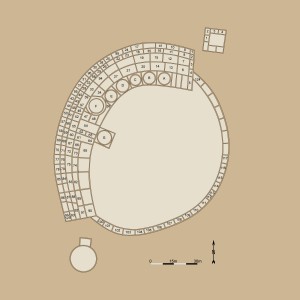Chaco Sites
Peñasco Blanco
Site Description:
One translation of the Spanish name is “white rock point.” The site name may derive from a noticeable light-colored ridge just south of the great house. The westernmost great house in Chaco Canyon, Peñasco Blanco sits about 2.7 miles (4.4 km.) northwest of Pueblo Bonito on the northwest tip of West Mesa where it overlooks the confluence of the Chaco and Escavada washes. Gordon and Gwinn Vivian have identified irrigation canals and a complex of fields in the Chaco floodplain below. In addition, recent studies have suggested a sand dam, supplemented at times by masonry, may have blocked the flow from Chaco Wash into the Escavada, creating a small lake during some time periods.
Peñasco Blanco is the third largest great house in Chaco Canyon and, along with Tsin Kletsin, is one of the only two canyon great houses located on the south side of Chaco Canyon. The oval ground plan is unlike any other great house and contrasts with the classic D-shape of many other canyon great houses. The main roomblock includes five rows of rooms that were up to three-stories. The enclosing arc consists of one row of single-story rooms. Peñasco Blanco has four great kivas, two in the plaza and two outside the building — more than any other great house. A small McElmo-style building lies just north of the great house. A Chacoan road runs south of the great house, passing near one of the great kivas outside the plaza.
Construction of the great house began in the early-10th century, with expansion of the original roomblock in the mid- and late-11th century. The single-row arc of rooms that encloses the plaza appears to have been added during a later construction episode. Although Peñasco Blanco was never formally excavated, Waylo and perhaps other Navajos reportedly dug a number of rooms in the building during the Hyde Exploring Expedition of the late 1890s, reportedly because they believed quantities of turquoise had been found there (CRA Accession #000429). The collections from the Hyde Expedition include ceramic vessels and other artifacts from the great house. During the National Geographic Society excavations in the 1920s, Frank Roberts trenched the trash mound to the east of the buildings to explore the stratigraphy and aid development of a ceramic type sequence for Chaco.
Alternate site designations include 29SJ410, LA 225, and Bc 250.
Excavation History
- 1923-1927: Excavated by Neil M. Judd of the National Geographic Expedition
- 1950: Leland Abel and Gordon Vivian of the National Park Service.
Size and Dates
- Approximately 300 rooms and 17 kivas
- Tree-ring dates indicate construction between A.D. 1060 and the early 1100s.
Site and Room Data
- Aztec West Ruins
- Bc 50 - Tseh So
- Bc 51
- Bc 53 - Roberts' Site
- Bc 57
- Bc 58
- Bc 59
- Chetro Ketl
- Pueblo Bonito
- Pueblo del Arroyo
- Shabik'eshchee
- Talus Unit #1


